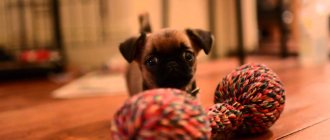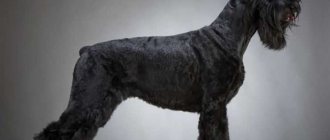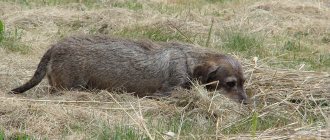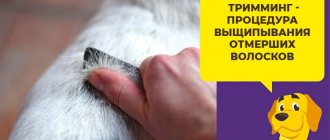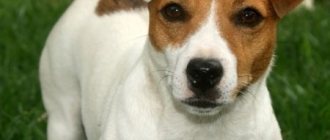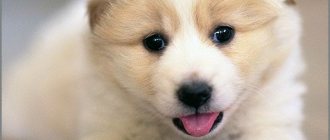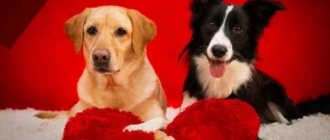At what age do you start training?
Puppy training must begin from the very first days
the presence of a dog in your home. Because already from infancy, the puppy must learn the rules of behavior in your house, what is allowed and what is forbidden, how to behave with all family members, even the smallest and oldest, what he can play with and what he can’t, where to go. toilet and much more.
And we are talking, first of all, about the proper upbringing of a griffon puppy, and you can start training and learning commands when the puppy is completely comfortable in your home. As a rule, one week is enough. By this time, the puppy is already filled with curiosity and is diligently exploring the world around him. If, after this time, the puppy remains fearful and does not make contact well, then it is better to seek help from a dog handler-animal psychologist, because This behavior is not typical for puppies of this breed.
When can you start training with a dog handler?
The beginning of the puppy's training coincides with the time of the first exit to the street. When the first two vaccinations have already been done, the quarantine (lasts 7-14 days, depending on the vaccination) after them is over. It is not at all necessary to train your puppy only outside; the first sessions are best done at home, where there are fewer distractions.
Often new puppy owners worry that training from the first days will be excessively stressful for the dog. This is only possible if outdated, rigid methods are used, and with the right approach, training from the first days will, on the contrary, be very useful, since it allows you to immediately establish contact
with the puppy and build a trusting relationship.
You can start raising a puppy from the first days of its appearance in your home, and training and classes with a dog handler can begin simultaneously with the start of walks, when quarantine ends after the second vaccination.
Why you don't need to wait up to 6 months
We often hear that griffons, like other dogs, cannot be trained before 6 months, because training is stressful. This opinion remains from the times of outdated methods based on cruel coercion and intimidation of the dog. Unfortunately, there are still plenty of dog handlers using similar techniques today. But fortunately, science does not stand still and modern techniques make it possible to train a puppy from the first days in a new home. Therefore, you should not wait until your Griffon puppy has established unwanted behavior; you can start training much earlier.
Brussels Griffon grooming
The Brussels Griffon is one of the most interesting and unique of all dwarf breeds. The modern variety of this breed is an improved version of the Belgian street dog crossed with the Affen Pinscher. Over the years, blood from other breeds was added to this crossbreed in order to impart a variety of qualities. Successful crossbreeding variants were supported, while unsuccessful ones were eliminated. Over time, a charming dog was born, similar to a terrier, with an almost human expression on its “face”, that is, as we know it now.
Although the Brussels Griffon is a rare dog, it is doing very well in the dog show world. Some Brussels Griffons have even become top winners in competitions for dogs of all breeds. The griffin was first demonstrated at the Brussels Exhibition in 1880 - as a breed of purely Belgian origin.
It is interesting that representatives of this breed can have two types of coat - hard and smooth. Both of these varieties of Brussels Griffons are equally wonderful companions for humans. They are kind, affectionate, obedient, and most importantly, their purpose is to be the favorite of the whole family.
Wool. There are two different types of wool - rough and smooth. Coarse wool should be fiber-like and dense, the stiffer it is, the better. Under no circumstances should the dog be fluffy, either in appearance or to the touch, and it should not have silky hair anywhere. The coat should not be so long that the dog appears shaggy, but at the same time the coat throughout the body should be clearly distinguishable from the smooth coat. The head should be covered with coarse hair, and the hair should be slightly longer around the eyes, nose, necks and chin, where it forms a decorative fringe. The smooth coat resembles that of a Boston Terrier or Bulldog, without evidence of wiry hairs.
Although griffons belonging to the wire-haired variety are more familiar to us, grooming is much easier for smooth-haired griffons. Wirehaired griffins require trimming twice a year. Smooth-haired dogs should be brushed and, after wiping with a towel, brought to shine by lightly rubbing with a velvet mitten or a piece of suede.
Grooming procedure / haircut, trimming Brussels Griffon
In addition to requiring basic grooming (brushing the coat, washing and drying the coat, cleaning the ears, and trimming the nails), the Brussels Griffon's coat must be plucked by hand as it is a wire-haired breed. Like all other wirehaired dog breeds, the Brussels Griffon's coat loses its natural texture and color when clipped.
The best equipment for everyday grooming of the Brussels Griffon is a brush or mitt made of natural bristles. Regular brushing of the coat reduces the need for frequent bathing. Since regular brushing rids the coat of dead hair, the need to brush the coat with a comb is also greatly reduced. Brushing the coat with a comb too often can cause the dog to lose too much of the living undercoat hair.
Owners of smooth-coated griffons, called Brabançons, can use pug grooming instructions as a guide.
Training at 2 months. Upbringing
At 2 months old, your griffon puppy is still at home, in quarantine after the first vaccinations, and he is not yet allowed to go for walks. Therefore, it’s time to start raising a puppy in the home conditions that are already familiar to him.
Toilet training
The first step is teaching the puppy to go to the toilet in a diaper . You should not rush to teach going to the toilet directly outside, bypassing this stage, because puppies are not physiologically ready for walking twice a day. Griffon puppies develop this ability no earlier than 6 months, and in some up to 1 year.
It should be remembered that any learning is a rather complex thing and, seeing the first positive results, you should not think that your puppy has already understood everything, but you should continue training according to the method, so that after a while you do not have to start all over again.
Collar and leash training
The second important point will be to accustom the puppy to a collar and leash . Yes, yes, this should be done at home, so that by the time the puppy goes outside for the first time, wearing a collar will not be additional stress for him, but is already a familiar thing, and he can start exploring the world around him, rather than trying to get rid of an unknown object.
What to allow a puppy and what not
The third point, which causes the greatest difficulty for new puppy owners, will be determining the puppy’s boundaries of what is permitted. Often, many novice dog owners think that the undesirable behavior of a griffon puppy will “go away on its own, outgrow it.” But, unfortunately, the behavior that is allowed for a puppy will be taken for granted later by an adult dog.
.
Any unwanted behavior in a puppy WILL NOT go away on its own, but will only become stronger over time.
Therefore, it is necessary to start defining the puppy’s boundaries of what is permitted now. You will need:
- Teach to play only with your toys, and not with your things;
- Explain that you cannot bite your hands even in a game;
- Establish the correct daily routine, establishing the rule that in the morning you need to sleep and not wake you up;
- Stop chewing furniture, clothes, walls and baseboards;
- Teach to stay home alone, knowing that your absence is not a reason to bark or howl.
IT IS EXTREMELY IMPORTANT TO KNOW: constant and excessive punishments that follow almost every action of the puppy have a detrimental effect on its fragile psyche and can lead to the Griffon puppy growing up cowardly and embittered. For normal natural development, a puppy must have the opportunity to explore the world around him, which is currently limited to your apartment or house.
Introduction to Basic Commands
Already now you should begin to familiarize yourself with the initial obedience commands in a light playful form, while focusing on rewards for execution, because the puppy’s psyche is still quite plastic and excessive severity and exactingness can lead to the puppy being intimidated and cowardly. Therefore, it is necessary, first of all, to try to interest the puppy by offering him a toy or treat, and sometimes just praise.
Ear care.
You should also periodically check and clean your ears if necessary (for example, once every 1-2 weeks). If the ears are healthy, then you can limit yourself to a simple examination.
You can remove excess wax with a dry cotton swab. If the discharge is very dry, the swab can be moistened with a small amount of hydrogen peroxide or a special sterile oil for cleaning the ears.
DO NOT use drops and lotions intended for the treatment of otitis media and especially ear mites for prevention! These products are usually sold freely in pet stores, but they cannot be used without a veterinarian’s prescription! They can cause allergies and inflammation.
To remove excess sulfur, you can only use products intended specifically for hygiene, and not for treatment. They should not contain antibiotics, hormones or acaricidal substances. Since the anatomy for the drops often only indicates the chemical formula, it can be difficult to figure it out on your own. Consult a veterinarian (AND NOT A PET STORE SALESPERSON!).
There is a basic rule: do not put any product in your dog’s ears (even if it says so on the package). Apply a small amount to a cotton swab and wipe the dog's ear.
To prevent ear mites, you can apply 1 drop of the drug Tsamaks to the auricle about 1 time per month.
Training at 3 months. Socialization
Three months is an important stage in a griffon puppy’s introduction to the outside world. Your first walks should be short and not too tiring for the puppy. You should start with 15 minutes, gradually increasing the walking time to 1 hour.
Correct formation of the nervous system
At this age, the puppy’s nervous system is forming.
. It has been proven that raising puppies in isolation during this important period contributed to the development of pronounced cowardice in them later. It is necessary to show the puppy as much as possible: noisy streets, large crowds of people, etc. Everything that he will have to face in later life.
This must be done very carefully, gradually, over and over again increasing the time spent in noisy places, so as not to overload the puppy or frighten him.
The territory of a country house, cottage or village are places with a minimum amount of external stimuli for a city dog. Therefore, if you plan to keep a dog in an urban environment, “growing up” a griffon puppy in such conditions depleted of stimuli is unacceptable.
A city puppy must grow up in the city, in conditions that are saturated with external stimuli, such as: noisy streets, large crowds of people, other animals, birds, cyclists, cars, etc.
Meeting people and dogs
It is necessary to introduce the puppy to friendly dogs and people
so that later the puppy does not develop aggression or cowardice caused by the fear of new things and the inability to communicate and make new acquaintances. Currently, unfortunately, this is not uncommon in the behavior of adult dogs, but a fairly common problem with which people turn to our specialists for help.
Puppy behavior on the street
The emergence of new places leads to new rules that need to be consolidated:
- Now you can and should go to the toilet on the street, and not stoically endure it, carrying everything home;
- Not every new person or dog wants to communicate, so you don’t need to run headlong to meet everyone;
- Not all food is healthy, so it should only be taken from the owner’s hands.
Training and practicing commands
Training a puppy follows the same principles as at 2 months. It should be remembered that at this age puppies develop conditioned reflexes quite easily, but they are forgotten just as quickly, so you should not scold the puppy for not following commands, especially if they have not been repeated for a long time, but you should pay more attention to learning new things and repeating already covered material .
Advantageous complex for a griffin:
A full range of care for your pet includes the following procedures :
Tender and caring hands - the administrator and the groomer!
Trimming according to the breed standard - in our salon, not expensive, but thorough trimming! Only in the Baluti salon, breed trimming according to the breed standard! We are for quality trimming! The dog must be trained according to the breed standard! PREPARATION FOR THE EXHIBITION!!!
Washing (optional) with professional products, conditioning;
Drying the wool with a professional hairdryer, which does not overheat the wool and does not dry it out, but blows water out of the wool;
Hygienic haircut: a mandatory procedure that is included in the complex in our pet salon
- treatment of paws, cutting of hair between toes, belly, hygiene areas;
Cleaning ears and eyes. Our master groomers will not ignore such an important procedure as cleaning the eyes and ears. Of course, ear cleaning is not the most pleasant procedure for an animal, but nevertheless it is mandatory. If you clean your ears regularly, your animal will get used to it and experience minimal discomfort. Nail trimming. Also one of the most important procedures. Too long claws prevent the griffon from moving fully. In the most neglected state, the claws form a spiral and grow into the paw pad. To prevent this, you need to trim your dog's nails regularly. However, the claws must be trimmed carefully, being careful not to damage living tissue. If you walk a lot with your pet, then this procedure can be avoided altogether - the claws wear off perfectly on the asphalt.
“Complex” is the most profitable service for your griffin, who will leave our salon clean, beautifully trimmed, with neat claws.
Training at 4 - 5 months
By this time, the griffon puppy has already become accustomed to your home and usual walking areas, and no longer needs your support and care so much. He begins to flirt with other dogs, pretend that he does not hear you when you call him, and show a certain persistence and disobedience when performing various commands.
This means it's time to move on to full training . In classes at this age you can already be persistent and demanding. At the same time, the most important thing is not to overdo it, remember that classes should bring joy to both you and your dog, and only then you can achieve the desired result.
Required commands in 4 months
What commands are practiced by a griffon puppy at 4 months:
- Calm movement next
to the owner with and without a leash, with landing when stopping, with a change in pace and direction of movement - Return to you
upon request - Staying
in a free or certain position (sitting, lying, standing) for a long time: if necessary, wait for the owner on the street, when visiting a store or other establishment - Indifferent attitude towards treats scattered on the ground
- Inhibitory command
to stop unwanted actions - Execution of a set of commands “sit”, “lie down”, “stand”
at a distance and near the leg, when giving commands by voice and gestures - Stop barking
on demand.
What do you know about griffin trimming?
Let's start with the fact that trimming the Brussels Griffon depends on the variety. As you know, there are three types of Griffon: Brussels, Belgian and Petit Brabançon. Moreover, the first two species are wire-haired, which means that trimming is necessary from childhood. It is necessary to accustom the Brussels Griffon to trimming gradually, and its trimming should be carried out in stages. From the beginning, the puppy must get used to the fact that the process of combing and pulling out fur is natural and necessary. It is better to start with stroking, scratching with soft brushes and combs with large teeth (their size depends primarily on the thickness and stiffness of the fur), accompanying this process with gentle pats “behind the ear” of your baby. It is important that he understands that you do not want to cause him harm or pain, he must trust you. This procedure should be carried out weekly, depending on the amount of fur of your pet and the time you are able to spend on it. I would like to immediately warn you that it is better to do combing at the same time and in the same place. So the dog gets used to this procedure as a kind of obligatory ritual and often waits for it. After all, many dogs really enjoy this process.
Training from 6 months
At this age, the puppy begins puberty and the real rebel awakens in him. He begins to re-test the boundaries of what is permitted and, sometimes, deliberately does not respond to your commands, only in order to look at your reaction. If she is not what the puppy expects to see, then he may decide that now he can no longer carry out your commands.
Remember that a puppy is still a child.
, and excessive harshness can forever undermine his trust in you.
At this stage of the Griffon puppy's growing up in training, all the shortcomings made at the previous stages, which were smoothed out by his young age, become clearly visible. And if they appear, it’s time to correct them.
In many training schools, there is an opinion that a puppy needs to be trained in two stages, the first at an early age, and the second at 8 - 10 months, in order to “consolidate” what has been learned. This is not an entirely correct position; this opinion appeared when newer operant training methods began to be added to the old “DOSAAF” rigid training methods, where they began to work with the puppy strictly after 6-7 months, including working with the method of pointing and following the “target”.
Their weakness was that they were two different techniques.
, which began to be used without adapting to each other, having a huge gap between their tools for developing training skills. The difference between them is like between choreography lessons in kindergarten and army drill training. Therefore, they required training in two stages, which were in no way connected with each other.
Modern methods based on zoopsychology make it possible to train a puppy in a single system , when no additional stages of training are required.
Description of the breed
The Belgian Griffon is a miniature, square-shaped dog with strong bones and an expressive muzzle. Its highlight is the human features of the “face”. This provides a constant reason for jokes and affection.
Breed standard:
- Dimensions: height does not have a standard, but averages range from 26 to 32 cm; weight: 3.5 - 6 kg.
- The head is large, with a rounded skull and convex forehead. A pronounced transition from the forehead to the muzzle.
- The nose is colored black. The nostrils are well cut.
- The lips are black, dense, and fit well together.
- The lower jaw is curved upward, slightly protruding beyond the upper. Snack.
- The eyes are quite large, round, but not protruding. Widely spaced. The iris is dark brown. Stroke black.
- The ears are miniature, high-set. Cropped and natural options are allowed. Uncropped ears should hang forward and not to the side.
- The neck is moderately long, gently blending into the withers.
- The back is short, strong, with a slightly convex loin.
- The chest is quite wide, with a pronounced sternum.
- The tail is high set, raised to the top. Cropped and natural options are allowed. In the first case, 2/3 of the usual length is left. A curled, short, broken tail is a defect in accordance with the standard.
- The limbs are parallel, with strong bones. The paws are neat and small. The shape is round.
The coat is hard, with a slight wave, and requires regular trimming. The face has characteristic eyebrows, beard and mustache. The cheekbones and muzzle are covered with long, thick hair. Soft, silky six is unacceptable by the standard.
Colors
The Belgian Griffon has only two color options: black and black and tan. The spots must be a clean, uniform color. A small amount of white chest hair is acceptable. White spots are considered a violation of the standard.
Our dog handlers
Griffon training specialists
Alexander Chaplygin Dog psychologist-zoopsychologist
Experience: 37 years Read more..
Ekaterina Panova Dog psychologist-zoopsychologist
Experience: 34 years Read more..
Yaroslav Morozov Dog psychologist-zoopsychologist
Experience: 25 years Read more..
Lada Yurtseva Dog psychologist-zoopsychologist
Experience: 21 years Read more..
Victoria Fox Dog psychologist-animal psychologist
Experience: 14 years Read more..
Ekaterina Budkina Dog psychologist-zoopsychologist
Experience: 13 years Read more..
Evgeniy Bravinsky Dog psychologist-zoopsychologist
Experience: 17 years Read more..
Vitalia Bravinskaya Dog psychologist-zoopsychologist
Experience: 10 years Read more..
Kira Ageeva Dog psychologist-zoopsychologist
Experience: 19 years Read more..
Evgenia Zuber Dog psychologist-zoopsychologist
Experience: 12 years Read more..
Tatyana Melnikova Dog psychologist-zoopsychologist
Experience: 10 years Read more..
Alexey Melikhov Dog psychologist-zoopsychologist
Experience: 22 years Read more..
* Check with the managers for the possibility of a specific specialist visiting the area you specified. If the desired dog handler does not work in your area, then we can offer you another specialist from the above.
Griffon puppy training
When you turn to our canine center for help in training a griffon puppy, you can be sure that a real specialist in his field
and will provide training at the proper, highest level.
- A dog trainer will come to your
home at a time convenient for you. - Classes are held 1-2 times a week
, depending on the program. - Instructors work from 9:00 to 21:00
, on weekends inclusive - The training program is drawn up at the first lesson,
taking into account the breed, age, personal characteristics of the dog and your wishes for training - Some classes take place at home
, some
outside
, depending on the topic of the lesson. - Puppy age
from 2 months
Our Center employs dog handlers - animal psychologists who have experience in working with griffon puppies and training adult dogs from 10 to 35 years old, who know all the nuances of their behavior
and features of training at each stage of a dog’s growth. Therefore, your pet is guaranteed to learn to carry out your commands the first time in any conditions, and will become your faithful and reliable companion.
Dental care.
Preventing gum disease is much easier than treating it. The most common cause of this disease is tartar, which prevents the gum from sealing tightly to the tooth. You need to examine your dog's teeth at least once every two weeks.
Brush your dog's teeth regularly! To do this, you can use bones from veins or other dry solid product from well-known companies.
You can brush your teeth with a special toothpaste for dogs (available in pet stores). Now the market offers products from various companies, including the American company 8 in 1 (eight in one). It offers toothpaste, toothbrushes, oral spray, menthol tablets, etc.
Ideally, dogs should have their teeth brushed as often as humans, especially if you like to kiss your dog's nose or let him lick your face. But I don't think you will do it that often, so it will be very good if you brush your dog's teeth at least once a week.
But if, nevertheless, tartar has formed, then in this case it is recommended to remove the tartar. It is necessary to remove it, it brings suffering to the dog and is often the cause of bad breath. You should consult your veterinarian regarding tartar removal. Today, there are two main methods for removing dental plaque - one of them is mechanical (using special tools), the second is ultrasonic (using an ultrasonic scaler). The ultrasonic scaler creates oscillatory movements, which results in the knocking down of tartar. Ultrasound removal of tartar does not damage tooth enamel.
